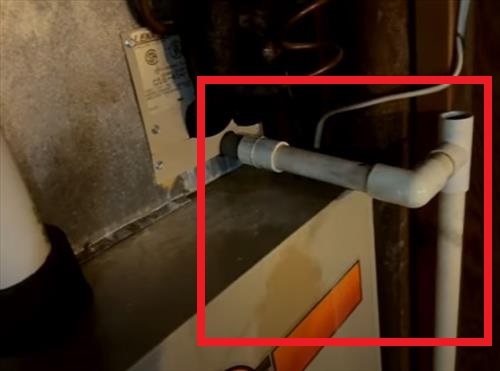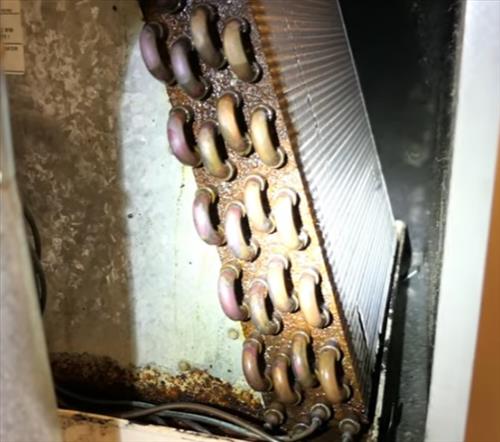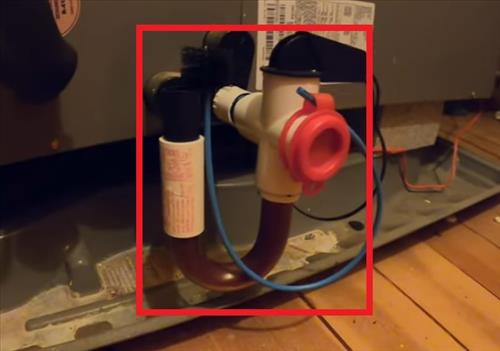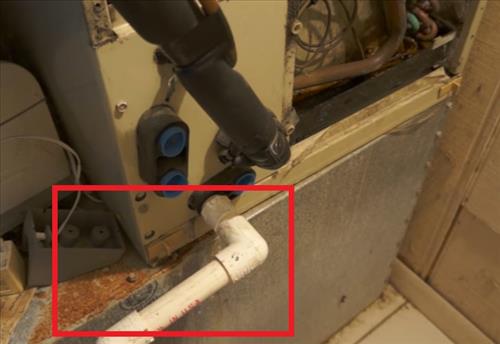- A leaky furnace is often caused by a clogged condensation line.
- Water condensation is a normal part of an HVAC system which must be let to drain away.
- Often unclogging the condensation line will solve the issue.
If you have a furnace that is leaking water, it’s likely because of a condensation drain problem.
Condensation drains are located at the bottom of the A-coil, which is usually located at the bottom of the furnace but can sometimes be on the top.
Why is My Furnace Leaking Water?

A blocked condensation line in a furnace may leak if it cannot drain.
Many furnaces work in combination with an air conditioner to cool in the summer and blow cold air into a home.
These types of systems are called split units, with the A-coil located at the bottom of the furnace and the condenser outside.
A split system works very well since the same blower motor and vents can be used to blow both hot and cold air into a home.
The indoor A-coil that is located at the bottom or top of the furnace can form moisture when the air is humid.
The moisture becomes water condensation that needs to be drained from the unit.
If the drain becomes blocked or plugged, the water can leak out and into a home.
What Causes Water to Leak from the Bottom of a Furnace?

The air conditioner A-Coil located at the bottom or top of the furnace is the usual cause of a water leak.
It is the same concept as when you put ice in your drink; the ice begins to cool the beverage and react with the warmer room air.
This cools the warm air, forming water droplets. The same process happens inside an HVAC system.
When cold meets something hot, it creates tiny droplets of liquid.
It is also possible for that condensation to turn into ice inside your system. If your HVAC system is running in cool mode and has a restriction in airflow, it can cause your indoor coil to develop ice. Once this happens, the condensation may have nowhere to go and may begin to drip into your furnace, giving it the appearance that your furnace is leaking.
How Do I Stop My Furnace From Leaking Water?

Unclogging the condensation drain line will usually stop a furnace from leaking water.
Open the bottom of the furnace and locate the pan at the bottom of the unit and find the drain.
The drain will likely be plugged up and need to be unclogged.
How Do You Unclog a Furnace Condensate Drain?
Most HVAC techs will use a wet vac to clean the bottom pain of any debris.
Often the pan has small debris that is clogging up the drain line.
Once the pan is cleaned, a small wire or similar can be used to open up the drain and allow for water to flow out again.
Is a Leaking Furnace an Emergency?
A leaking furnace is not an emergency as the unit will still usually operate.
While it may not be an emergency, the water may cause damage to some floors.
It likely is best to turn off the air conditioner until the unit is fixed.
Summary
A furnace with water leaking out the bottom is condensation from the air conditioner A-Coil.
The A-Coil is located at the bottom of the furnace in the popular split system style HVAC systems.
Opening up the bottom door of the furnace and examining the drain pan will likely show it contains debris that needs to be cleaned out.
The drain line will need to be cleared of any debris that is stopping water from draining out.
Have you had an issue with a furnace leaking water? Let us know your thoughts below.
